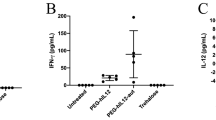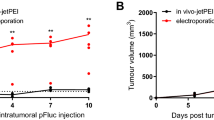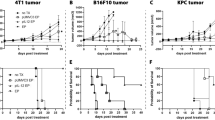Abstract
Intravenous endostatin gene transfection results in tumor suppression in a murine pulmonary metastasis model. We transfected the endostatin gene at different times, in order to achieve an optimal protective effect. pST2-Endo encoding murine endostatin was injected in a complex with cationic lipid. Pulmonary metastases were caused by intravenous injection of murine fibrosarcoma cells. Mice were observed for 14 days following fibrosarcoma cell inoculation (FSI). In the study groups, the animals were transfected with pST2-Endo at three different times: 2 days before and 3 and 7 days after FSI. In the group transfected with pST2-Endo 2 days before FSI, the weights of the lungs and tumor-occupied area ratio were significantly less than in the other groups. Significant inhibition of tumor neovascularization was documented by means of CD31 immunohistochemistry. The effect of repeated endostatin transfection on survival after FSI was determined. Animals repeatedly transfected with the endostatin gene survived significantly longer than the groups treated with a single endostatin gene transfection. A stable endostatin-expressing fibrosarcoma transfectant was created and tested for migration and invasion. Compared with controls, endostatin expression reduced migration and invasion by 15%. It is concluded that endostation gene transfection before FSI and repeated transfection thereafter results in significant tumor suppression.
This is a preview of subscription content, access via your institution
Access options
Subscribe to this journal
Receive 12 print issues and online access
$259.00 per year
only $21.58 per issue
Buy this article
- Purchase on Springer Link
- Instant access to full article PDF
Prices may be subject to local taxes which are calculated during checkout







Similar content being viewed by others
References
Folkman J . Angiogenesis in cancer, vascular, rheumatoid and other disease. Nat Med. 1995;1:27–31.
Hanahan D, Folkman J . Patterns and emerging mechanisms of the angiogenic switch during tumorigenesis. Cell. 1996;86:353–364.
Boehm T, Folkman J, Browder T, O'Reilly MS . Antiangiogenic therapy of experimental cancer does not induce acquired drug resistance. Nature. 1997;390:404–407.
O'Reilly MS, Boehm T, Shing Y, et al. Endostatin: an endogenous inhibitor of angiogenesis and tumor growth. Cell. 1997;88:277–285.
Yamaguchi N, Anand-Apte B, Lee M, et al. Endostatin inhibits VEGF-induced endothelial cell migration and tumor growth independently of zinc binding. EMBO J. 1999;18:4414–4423.
Hanai J, Dhanabal M, Karumanchi SA, et al. Endostatin causes G1 arrest of endothelial cells through inhibition of cyclin D1. J Biol Chem. 2002;277:16464–16469.
Putney SD, Burke PA . Improving protein therapeutics with sustained-release formulations. Nat Biotechnol. 1998;16:153–157.
Crystal RG . The body as a manufacturer of endostatin. Nat Biotechnol. 1999;17:336–337.
Kisker O, Becker CM, Prox D, et al. Continuous administration of endostatin by intraperitoneally implanted osmotic pump improves the efficacy and potency of therapy in a mouse xenograft tumor model. Cancer Res. 2001;61:7669–7674.
Nakashima Y, Yano M, Kobayashi Y, et al. Endostatin gene therapy on murine lung metastases model utilizing cationic vector-mediated intravenous gene delivery. Gene Therapy. 2003;10:123–130.
Bergers G, Javaherian K, Lo KM, Folkman J, Hanahan D . Effects of angiogenesis inhibitors on multistage carcinogenesis in mice. Science. 1999;284:808–812.
DeLisser HM, Christofidou-Solomidou M, Strieter RM, et al. Involvement of endothelial PECAM-1/CD31 in angiogenesis. Am J Pathol. 1997;151:671–677.
Yew NS, Wysokenski DM, Wang KX, et al. Optimization of plasmid vectors for high-level expression in lung epithelial cells. Hum Gene Ther. 1997;8:575–584.
Song YK, Liu F, Chu S, Liu D . Characterization of cationic liposome-mediated gene transfer in vivo by intravenous administration. Hum Gene Ther. 1997;8:1585–1594.
Sauter BV, Martinet O, Zhang WJ, Mandeli J, Woo SL . Adenovirus-mediated gene transfer of endostatin in vivo results in high level of transgene expression and inhibition of tumor growth and metastases. Proc Natl Acad Sci USA. 2000;97:4802–4807.
Jin X, Bookstein R, Wills K, et al. Evaluation of endostatin antiangiogenesis gene therapy in vitro and in vivo. Cancer Gene Ther. 2001;8:982–989.
Marshall E . Cancer therapy. Setbacks for endostatin. Science. 2002;295:2198–2199.
Yew NS, Wang KX, Przybylska M, et al. Contribution of plasmid DNA to inflammation in the lung after administration of cationic lipid:pDNA complexes. Hum Gene Ther. 1999;10:223–234.
Whitmore MM, Li S, Falo Jr L, Huang L . Systemic administration of LPD prepared with CpG oligonucleotides inhibits the growth of established pulmonary metastases by stimulating innate and acquired antitumor immune responses. Cancer Immunol Immunother. 2001;50:503–514.
Mundhenke C, Thomas JP, Wilding G, et al. Tissue examination to monitor antiangiogenic therapy: a phase I clinical trial with endostatin. Clin Cancer Res. 2001;7:3366–3374.
Acknowledgements
We gratefully acknowledge Dr Koichi Ando (National Institute of Radiological Sciences, Chiba, Japan) for providing the murine fibrosarcoma cell line NFSa Y83. We thank Ms A Miyazaki, Ms M Nishio, and Ms S Makino for technical assistance.
Author information
Authors and Affiliations
Corresponding author
Rights and permissions
About this article
Cite this article
Yano, M., Nakashima, Y., Kobayashi, Y. et al. Endostatin gene transfection using a cationic lipid: advantages of transfection before tumor cell inoculation and repeated transfection. Cancer Gene Ther 11, 354–362 (2004). https://doi.org/10.1038/sj.cgt.7700704
Received:
Published:
Issue Date:
DOI: https://doi.org/10.1038/sj.cgt.7700704
Keywords
This article is cited by
-
Liposome–DNA complexes infused intravenously inhibit tumor angiogenesis and elicit antitumor activity in dogs with soft tissue sarcoma
Cancer Gene Therapy (2006)
-
Early endostatin treatment inhibits metastatic seeding of murine colorectal cancer cells in the liver and their adhesion to endothelial cells
British Journal of Cancer (2005)



